Shalom from Tel Aviv and Jerusalem
On our second full day in Israel, we decided to visit some of the more historic areas of Tel Aviv itself, and then have lunch with a friend who was a visiting fellow at the Washington Institute (where I work) last autumn. After that we visited the Diaspora Museum and then said "l'hitraot" to Tel Aviv and traveled to Jerusalem.
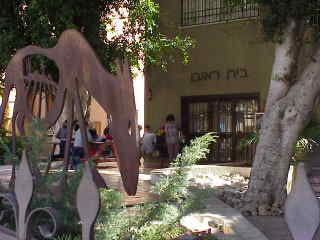 The picture to the left is of
Reuven Rubin's home; he was a famous Israeli artist, and he lived on
Rehov Bialik, a street recommended in, where else, Fodor's, as one
of the better-kept, historic areas of old (pre-Israel) Tel Aviv. We didn't
actually go into Rubin's home, but we did see other homes on the street.
The picture to the left is of
Reuven Rubin's home; he was a famous Israeli artist, and he lived on
Rehov Bialik, a street recommended in, where else, Fodor's, as one
of the better-kept, historic areas of old (pre-Israel) Tel Aviv. We didn't
actually go into Rubin's home, but we did see other homes on the street.
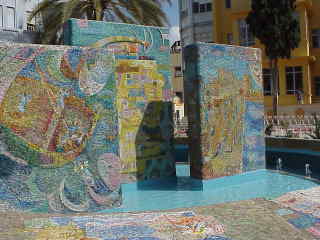 The picture to the right is a mosaic water fountain created
by another early Israeli artist, Nahum Gutmann. It depicts the history of Tel
Aviv from ancient times to the rise of the modern city.
The picture to the right is a mosaic water fountain created
by another early Israeli artist, Nahum Gutmann. It depicts the history of Tel
Aviv from ancient times to the rise of the modern city.
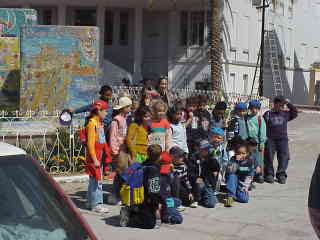 The picture to the left is of a group of Israeli school kids
getting their photo taken by their teacher in front of the fountain; it
looked too precious not to take!
The picture to the left is of a group of Israeli school kids
getting their photo taken by their teacher in front of the fountain; it
looked too precious not to take!
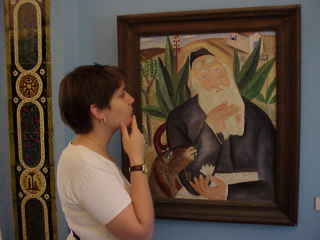 The picture to the right is of me looking at
a picture painted by Reuven Rubin, hanging in Beit Bialik. Chaim Nachman
Bialik was a former national poet considered the father of Hebrew poetry,
and his house was a great place to tour, although all the descriptions of
the photos and paintings were in Hebrew. Oh well. It gave me practice
trying to spot words and letters I knew. (By the end of the trip, I got pretty
good at reading Hebrew road signs, some ads, and other notices.)
The picture to the right is of me looking at
a picture painted by Reuven Rubin, hanging in Beit Bialik. Chaim Nachman
Bialik was a former national poet considered the father of Hebrew poetry,
and his house was a great place to tour, although all the descriptions of
the photos and paintings were in Hebrew. Oh well. It gave me practice
trying to spot words and letters I knew. (By the end of the trip, I got pretty
good at reading Hebrew road signs, some ads, and other notices.)
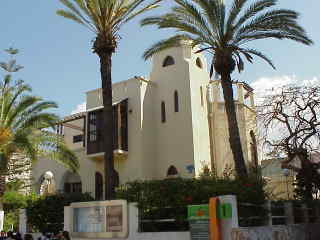 The image to the left is Beit Bialik from the outside; according
to Fodor's, it was a large place, considered palatial for the
austere pre-Independence days (and we can believe it).
The image to the left is Beit Bialik from the outside; according
to Fodor's, it was a large place, considered palatial for the
austere pre-Independence days (and we can believe it).
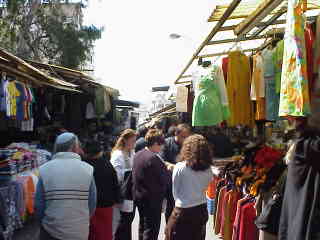 The text that follows is Adam's impression of the Carmel market
(written during our trip, of course). The picture to the right is
of the market, as is the photo of a huge stand of olives, below
to the left. And now, he-e-e-e-e-ere's Adam...
The text that follows is Adam's impression of the Carmel market
(written during our trip, of course). The picture to the right is
of the market, as is the photo of a huge stand of olives, below
to the left. And now, he-e-e-e-e-ere's Adam...
Wow, what a cacophony. If Stephen Glass ever writes one of his
postmodern pieces including smells, vendor calls and colors, it will
be based on the Carmel Market. The constant calls of "Shesh shekel!
Shesh shekel! Shesh shekel!" combined with the mixed smells of
strawberries, garlic, spices, fish, polyester clothing and silver
polish was almost too much to bear. Highly amusing nonetheless.
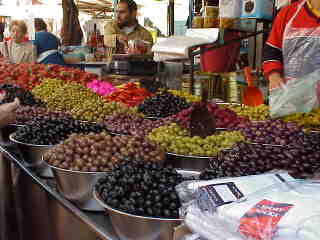 Monica was amazed by the olive selection; neither of us had ever
seen such a variety before, and in such quantity [even in Italy--
go figure. --MNH]. The prices were also unbelievably low; as little
as 2.50 shekels (about 70 cents) for a half kilo of fresh
strawberries.
Monica was amazed by the olive selection; neither of us had ever
seen such a variety before, and in such quantity [even in Italy--
go figure. --MNH]. The prices were also unbelievably low; as little
as 2.50 shekels (about 70 cents) for a half kilo of fresh
strawberries.
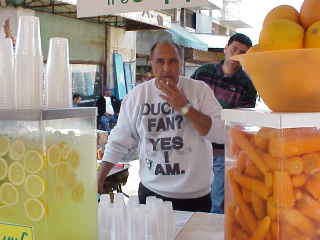 OK, it's Monica writing again. The picture to the right is for Bill
Neal and all the other Mighty Ducks fans in Orange County, Calif., and
elsewhere.
OK, it's Monica writing again. The picture to the right is for Bill
Neal and all the other Mighty Ducks fans in Orange County, Calif., and
elsewhere.
The guy wearing the shirt was a fresh-squeezed-carrot-juice vendor in the Carmel Market, and when we saw him in his Mighty Ducks shirt, I tried to make a joke about it, but he looked at me as if I were daffy (pun intended). It turned out that not only did he have no idea who the Ducks were; he couldn't even speak English.
We bought the carrot juice anyway.
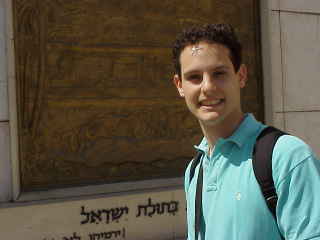 It's Adam, back and usurping Monica's place. The pic on the left is the
memorial outside the Independence Hall, to which we wandered after
elbowing our way out of the Carmel Market.
It's Adam, back and usurping Monica's place. The pic on the left is the
memorial outside the Independence Hall, to which we wandered after
elbowing our way out of the Carmel Market.
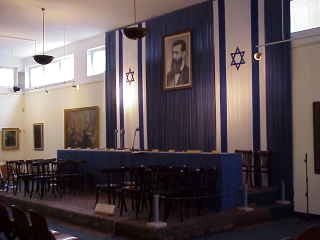 And, not surprisingly,
to the right is Independence Hall itself. A lot of pro-Israel
puffery, but some interesting notes as well. Apparently, for
instance, the revolutionary committee was considering the name
"Western Palestine" as the name for the new country. Additionally,
the committee decided to call the country "Yisrael" in Hebrew "so
as to make it easier for any Arab nations" that might arise, since
that is how they called it already. Okay, here's your main
tour guide, Monica, again.
And, not surprisingly,
to the right is Independence Hall itself. A lot of pro-Israel
puffery, but some interesting notes as well. Apparently, for
instance, the revolutionary committee was considering the name
"Western Palestine" as the name for the new country. Additionally,
the committee decided to call the country "Yisrael" in Hebrew "so
as to make it easier for any Arab nations" that might arise, since
that is how they called it already. Okay, here's your main
tour guide, Monica, again.
 After touring the Independence Hall, we got in a cab and headed to
Ramat Aviv Gimel, near Tel Aviv University, to meet Ze'ev Schiff, the
military editor of Ha'aretz newspaper, for lunch.
After touring the Independence Hall, we got in a cab and headed to
Ramat Aviv Gimel, near Tel Aviv University, to meet Ze'ev Schiff, the
military editor of Ha'aretz newspaper, for lunch.
Ze'ev had given us the name of the restaurant
but the cabbie was clueless, so we were a few minutes late in arriving
(but for those who know us, being late isn't a big surprise, is it?)
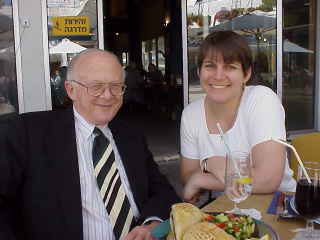 Ze'ev, a friend and colleague of mine (he regularly visits the Institute
and has written a few books for us), is billed at work as the "dean of
Israel's military correspondents." It was great to see him and to talk of
domestic Israeli as well as internal Institute politics.
Ze'ev, a friend and colleague of mine (he regularly visits the Institute
and has written a few books for us), is billed at work as the "dean of
Israel's military correspondents." It was great to see him and to talk of
domestic Israeli as well as internal Institute politics.
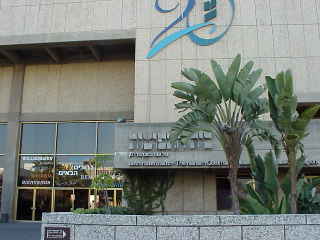 After lunch with Ze'ev, Adam and I hotfooted it over to Beth Hatefutsoth,
the Diaspora Museum, at Tel Aviv University (in Ramat Aviv).
After lunch with Ze'ev, Adam and I hotfooted it over to Beth Hatefutsoth,
the Diaspora Museum, at Tel Aviv University (in Ramat Aviv).
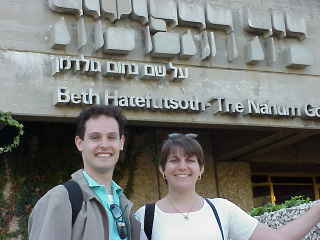
The only pictures we got are of the outside of the museum. (The one to the right was taken by a fellow tourist, from the Bay Area in California, who was fascinated by the camera; he had never seen one before, but I think he took a pretty good shot. The nice feature is that you can see the image immediately afterward, so even if he hadn't taken a nice shot, we could have deleted it and then lured another unsuspecting tourist into taking a picture of us.)
It would have been nice to photograph the inside, but no photography was allowed.
I will now let Adam add his two cents about this museum, although
unfortunately we didn't get
to spend nearly enough time there (we had to get to Jerusalem to meet Akiva,
our host, at 6 p.m.).
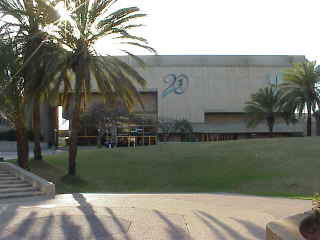 Here are Adam's real-time musings (written later that day, in Jerusalem) . . .
Here are Adam's real-time musings (written later that day, in Jerusalem) . . .
As Monica mentioned, quite a rushed tour of the museum, which was a bit
unfortunate. I was displeased with the number of beautiful artworks
that said, "Replica" or "Facsimile," but I guess many of the originals
have been destroyed or lost. By far the greatest highlight of the museum,
as Grandma Libbie had suggested, were the models of synagogues from around
the world. Some particularly fascinating temples have since been lost,
such as the Chinese one. Others interested me because I had seen them
(such as the temple in Amsterdam, which I had seen with Mom and Dad Hertzman
and Ruth on our trip there. Monica liked the one designed by Frank Lloyd Wright.
 Other interesting elements of the museum included photos of Jewish weddings
from around the world and songs from various congregations. I also enjoyed the
full wall describing the history of Judaism in art, ethics, kaballah,
and so forth.
Other interesting elements of the museum included photos of Jewish weddings
from around the world and songs from various congregations. I also enjoyed the
full wall describing the history of Judaism in art, ethics, kaballah,
and so forth.
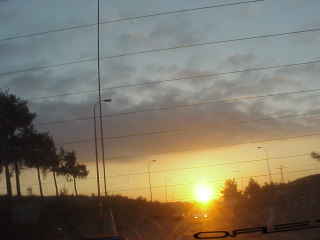 After we picked up our bags at the Hotel Ami, we hailed another cab to take us
to the bus station. But when he asked where we were going, and we said Jerusalem,
he said he would take us there "for only 250 shekels." That is, about $60. Which
seemed reasonable enough to us, and it meant we would get there faster (no waiting
for the bus to leave, no confusion at the bus station, etc.) and we were already
running late, and it was rush hour... So we said yes. Oh, the picture to the left is of
the sunset out the rear window of the cab as we approached Jerusalem.
After we picked up our bags at the Hotel Ami, we hailed another cab to take us
to the bus station. But when he asked where we were going, and we said Jerusalem,
he said he would take us there "for only 250 shekels." That is, about $60. Which
seemed reasonable enough to us, and it meant we would get there faster (no waiting
for the bus to leave, no confusion at the bus station, etc.) and we were already
running late, and it was rush hour... So we said yes. Oh, the picture to the left is of
the sunset out the rear window of the cab as we approached Jerusalem.
(As it turned out, I later saw a sign in the King David Hotel listing unmetered, fixed rates taxis are allowed to charge between major cities; the Tel Aviv-Jerusalem trip is supposed to be only about 180 shekels. Oh well. It was a fun ride and, as "they" say, an experience.)
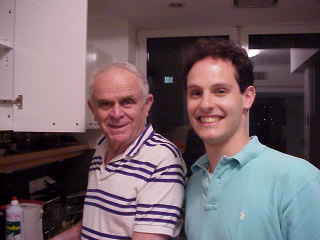 So, again a little late, we finally arrived in Jerusalem. Akiva had
already eaten, but he heated up some food Dina had left and we
had a tasty meal--an appetizer of hummous and pita, then chicken soup
with kneidlach, and then breaded chicken kind of like the schnitzel
Adam had in Tel Aviv, but with a lemon flavor.
So, again a little late, we finally arrived in Jerusalem. Akiva had
already eaten, but he heated up some food Dina had left and we
had a tasty meal--an appetizer of hummous and pita, then chicken soup
with kneidlach, and then breaded chicken kind of like the schnitzel
Adam had in Tel Aviv, but with a lemon flavor.
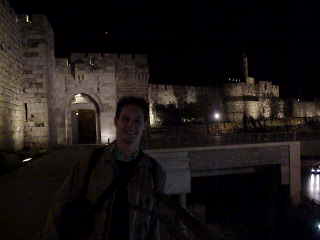 After dinner, much to Akiva's amazement ("You're not tired?")
we headed into town to upload images from our day in Tel Aviv.
I had the address of an internet bar, Strudel, and found it on a map
even before we arrived, so I knew it wasn't far (though I had neglected
to take into account all the hills on which Jerusalem is built--we got
our exercise, walking to and from the Old City!).
After dinner, much to Akiva's amazement ("You're not tired?")
we headed into town to upload images from our day in Tel Aviv.
I had the address of an internet bar, Strudel, and found it on a map
even before we arrived, so I knew it wasn't far (though I had neglected
to take into account all the hills on which Jerusalem is built--we got
our exercise, walking to and from the Old City!).
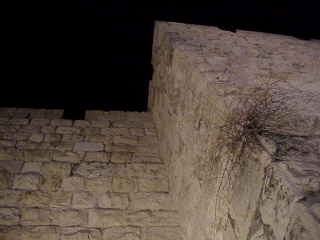 We took the long way to get to the internet place, and we passed the
Jaffa Gate on the way; to the right is a photo we took; though it's not
that great a photo, it was cool for me to see the walls of the Old
City, so I couldn't resist.
We took the long way to get to the internet place, and we passed the
Jaffa Gate on the way; to the right is a photo we took; though it's not
that great a photo, it was cool for me to see the walls of the Old
City, so I couldn't resist.
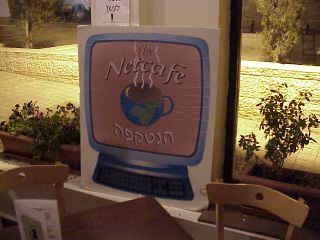 As we were walking there (apparently we were only two blocks away
by then), Adam noticed another place that advertised internet access,
so we walked in. Thus began our regular trips to NetCafe, on Rehov
Helene HaMalka, near the famous Le Tsriff restaurant and sorta near
the Jaffa Gate in Jerusalem. On one occasion, you will later read, we
did venture out to Strudel, but NetCafe had the estimable advantage
of being a smoke-free environment.
As we were walking there (apparently we were only two blocks away
by then), Adam noticed another place that advertised internet access,
so we walked in. Thus began our regular trips to NetCafe, on Rehov
Helene HaMalka, near the famous Le Tsriff restaurant and sorta near
the Jaffa Gate in Jerusalem. On one occasion, you will later read, we
did venture out to Strudel, but NetCafe had the estimable advantage
of being a smoke-free environment.
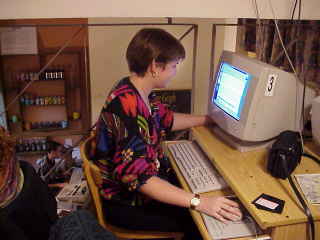 So, I started hacking code and Adam read the paper downstairs, and then
when I wanted to take a break I left Adam some space and told him to
fill in his thoughts (thus began the pattern).
So, I started hacking code and Adam read the paper downstairs, and then
when I wanted to take a break I left Adam some space and told him to
fill in his thoughts (thus began the pattern).
 The picture to the left is the view of the PC area upstairs at Netcafe.
The picture to the left is the view of the PC area upstairs at Netcafe.
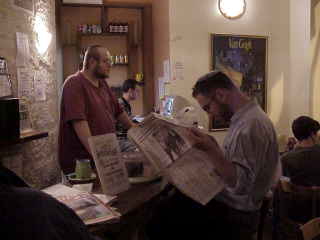 At one point, while Adam was typing away upstairs, I got to talking
with Niv Goldberg (the brunette in the background) and his hirsute
colleague in the foreground, Sasha Shekhtman. Neither of them still
works at NetCafe, we recently learned, but all the employees there were
nice, and it was a great place to relax and read email (and grab a great
piece of kosher-dairy chocolate cake) at the end of the day.
At one point, while Adam was typing away upstairs, I got to talking
with Niv Goldberg (the brunette in the background) and his hirsute
colleague in the foreground, Sasha Shekhtman. Neither of them still
works at NetCafe, we recently learned, but all the employees there were
nice, and it was a great place to relax and read email (and grab a great
piece of kosher-dairy chocolate cake) at the end of the day.
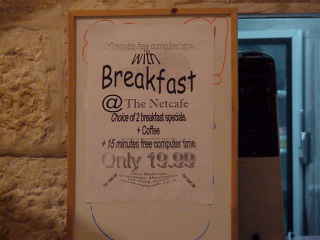 We were intrigued by the breakfast offer, but it turned out that Akiva kept leaving us plenty of breakfast foods, so we never did take NetCafe up on the offer (by the way, the 19.99 is in shekels, or about $5, so it was a pretty good deal).
We were intrigued by the breakfast offer, but it turned out that Akiva kept leaving us plenty of breakfast foods, so we never did take NetCafe up on the offer (by the way, the 19.99 is in shekels, or about $5, so it was a pretty good deal).
Thus ended Day 2 (March 16).
As ever, click here to continue with the tour.
Click here to return to
the previous page.
Click here to go back to the original home page.
Click here to go back to the edited home page.
And don't forget, click here to write to us.
Last updated July 2, 1999.